Hi Everyone!! This article will share The Village Blacksmith Questions & Answers.
This poem is written by Henry Wadsworth Longfellow. In my previous posts, I have shared the questions and answers of The Blue Carbuncle, Vagabond and Ballad of Father Gilligan so, you can check these posts as well.
The Village Blacksmith Questions & Answers
Word Galaxy
- Smithy – a blacksmith’s workshop
- Sinewy – lean and muscular
- Brawny – physically strong
- Bellows – emit a deep loud roar, typically in pain or anger
- Sledge – a vehicle on runners for conveying loads or passengers over snow often pulled by draught animals
- Forge – shape a metal object by heating it in a furnace and hammering it
- Threshing – separate grain from chaff by the action of revolving mechanism
- Rejoice – show great joy
- Toiling – work extremely hard
- Repose – state of rest
- Anvil – a heavy iron block with a flat top and concave sides on which metal can be hammered and shaped
Question 1: Choose the correct option:
(a) Which statement best expresses the comparison made in the following lines?
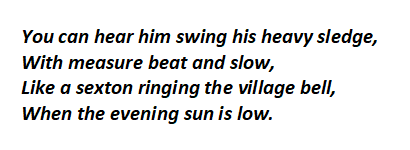
i. The blacksmith is a holy man like the sexton.
ii. The blacksmith’s steady pounding matches the sexton’s steady bell ringing.
iii. The blacksmith and the sexton both work as late afternoon turns to evening.
iv. The blacksmith and the sexton are both very strong and brawny.
(b) The daughter’s voice sounds to the smith like……..
i. her mother’s voice
ii. his own voice
iii. chirping of birds
iv. angels of paradise
(c) What comparison is made in the final stanza?
i. Life, like the work of the blacksmith, can be difficult.
ii. A blacksmith is like a teacher who molds human lives.
iii. Life is like the fire of the blacksmith’s forge; it may strengthen us or burn us.
iv. We must shape our lives with actions and ideas like the blacksmith shapes metal by heating and pounding it.
Question 2: What are the three physical characteristics of the village blacksmith?
Answer: The poet describes the blacksmith as a large, strong man with crisp, long, black hair and a tanned face. He has large and sinewy hands. The muscles of his brawny arms are compared to iron bands to emphasise the Blacksmith’s physical strength.
Question 3: Read and answer the questions:
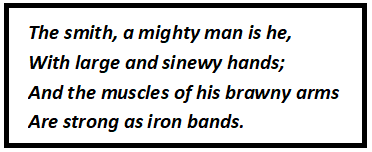
(a) Who does ‘smith’ refer to?
Answer: ‘Smith’ refers to the village blacksmith.
(b) Where does the smith have his workshop?
Answer: The smith has his workshop under the spreading chestnut tree.
(c) Name and explain the figure of speech in the following line:
With large and sinewy hands;
Answer: Tautology: Same ideas are expressed through ‘large’ and ‘sinewy’.
The Village Blacksmith Questions & Answers
Question 4: Which words are used to describe the strength of the blacksmith?
Answer: He looks strong, having strong arms and muscles with large powerful hands.
Question 5: “Week in, week out……sun is low.” Poets often compare to help form an image in the mind, to what is the blacksmith’s swinging of his sledge compared?
Answer: The blacksmith’s swinging of his sledge is compared to a sexton ringing the village bell.
Question 6: Pick out the words or lines that bring out the hard work the blacksmith does.
Answer:
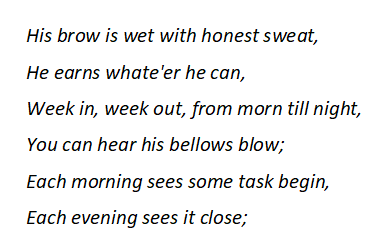
Question 7: What are happy and sad moments the blacksmith experiences on Sunday?
Answer: On Sundays, the blacksmith goes to church where he is very happy to hear his daughter singing in the village choir. Her voice reminds him of his wife singing in Paradise and he wipes his tears when he thinks of his wife resting in her grave.
Question 8: How do you know that the blacksmith is an honest man?
Answer: The poet gives a very flattering portrait of the village blacksmith. He is a man who seems to have no negative character traits whatsoever. He is incredibly hardworking, he regularly goes to church, he is immensely proud of his daughter when she sings in the village choir, and he still cries over his dear, departed wife. All of these traits point out to his honesty.
Question 9: In the last verse, why does the persona thank the blacksmith?
Answer: The persona thanks the blacksmith because he has learnt the lesson of life with its trials, toils and difficulties. One learns too face hardships even as one pursues good deeds and thoughts. We are makers of our own fate and each day we shape our future and life with our own efforts.
Question 10: Why is the blacksmith able to look at the whole world ‘in the face’?
Answer: The blacksmith is able to look the whole world in the face, because he is an honest man, so he doesn’t owe anything to anyone.
The Village Blacksmith Questions & Answers
Question 11: Read and answer the questions:
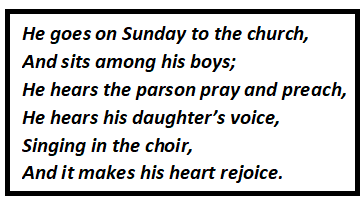
(a) How do you know that the village smith is a religious person?
Answer: The village smith is a religious person because he visits the church every Sunday and hears the parson preach and pray.
(b) Of what does the smith’s daughter’s voice remind him?
Answer: The smith’s daughter’s voice reminds him of his dead wife.
(c) What is the rhyme scheme of the above stanza? Give the rhyming words.
Answer: The rhyme scheme is abacdc.
Rhyming words are church – preach, voice – rejoice.
Question 12: Read and answer the questions:
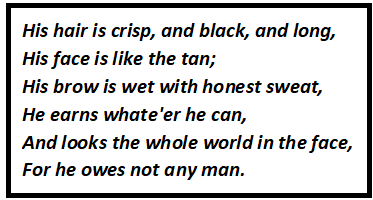
(a) Who is described in these lines?
Answer: The blacksmith is described in these lines.
(b) What does the expression looks the whole world in the face mean?
Answer: This means that the blacksmith, being an honest man, does not shy away with guilt and can look anyone in the face or meet his eye.
(c) How is blacksmith described in the above lines? What impression do you gather of him?
Answer: The blacksmith has long, black hair; his face has turned brown; the sweat of honesty is on his brow; and he earns through honest work. he works hard for his living and being an honest man in his work, he does not have to shy away with guilt.
(d) Which words tell you that he is honest and hardworking?
Answer: The words brow is wet with honest sweat, earns whate’er he can, looks the world in the face tell us that he is honest and hardworking.
Question 13: Read and answer the questions:
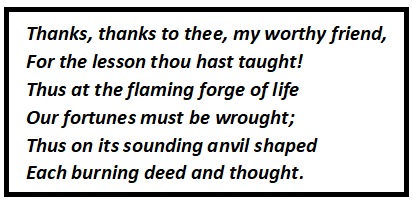
(a) Who is the worthy friend referred to here?
Answer: The blacksmith is the worthy friend.
(b) Explain flaming forge of life.
Answer: The hardships and trials one has to face in life to achieve anything is like the burning forge of life, like iron goes through fire to be beaten into the desired shape.
(c) What lesson does the blacksmith teach us?
Answer: The lesson learnt is that hard and honest work pays and one must be persistent to achieve a goal at the end of the day or in life.
(d) What do the last two lines of the poem mean?
Answer: Nothing is gained without an attempt to complete the task. Achieving a goal leads to a peaceful, satisfactory sleep at night.
So, these were The Village Blacksmith Questions & Answers.